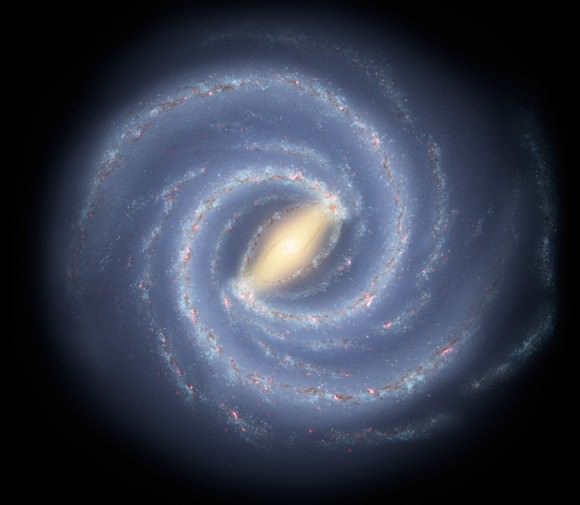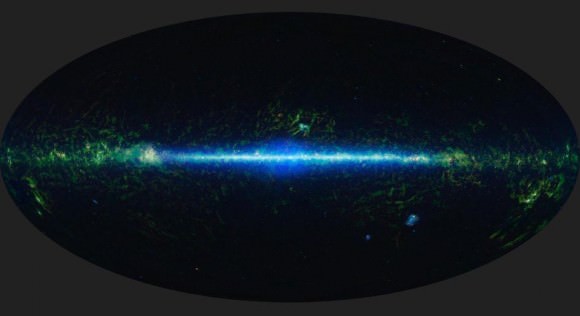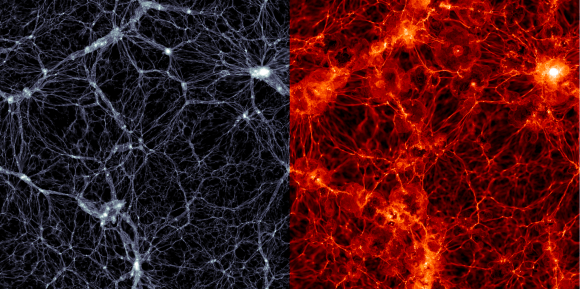When you look up at the night sky, assuming conditions are just right, you might just catch a glimpse of a faint, white band reaching across the heavens. This band, upon closer observation, looks speckled and dusty, filled with a million tiny points of light and halos of glowing matter. What you are seeing is the Milky Way, something that astronomers and stargazers alike have been staring up at since the beginning of time.
But just what is the Milky Way? Well, simply put, it is the name of the barred spiral galaxy in which our solar system is located. The Earth orbits the Sun in the Solar System, and the Solar System is embedded within this vast galaxy of stars. It is just one of hundreds of billions of galaxies in the Universe, and ours is called the Milky Way because the disk of the galaxy appears to be spanning the night sky like a hazy band of glowing white light.
Discovery and Naming:
Our galaxy was named because of the way the haze it casts in the night sky resembled spilled milk. This name is also quite ancient. It is a translation from the Latin “Via Lactea“, which in turn was translated from the Greek for Galaxias, referring to the pale band of light formed by stars in the galactic plane as seen from Earth.
Persian astronomer Nasir al-Din al-Tusi (1201–1274) even spelled it out in his book Tadhkira: “The Milky Way, i.e. the Galaxy, is made up of a very large number of small, tightly clustered stars, which, on account of their concentration and smallness, seem to be cloudy patches. Because of this, it was likened to milk in color.”

Astronomers had long suspected the Milky Way was made up of stars, but it wasn’t proven until 1610 when Galileo Galilei turned his rudimentary telescope towards the heavens and resolved individual stars in the band across the sky. With the help of telescopes, astronomers realized that there were many, many more stars in the sky and that all of the ones that we can see are a part of the Milky Way.
In 1755, Immanuel Kant proposed that the Milky Way was a large collection of stars held together by mutual gravity. Just like the Solar System, this collection of stars would be rotating and flattened out as a disk, with the Solar System embedded within it. Astronomer William Herschel (who discovered Uranus) attempted to actually map out the shape of the Milky Way in 1785, but he didn’t realize that large portions of the galaxy are obscured by gas and dust, which hide its true shape.
It wasn’t until the 1920s when Edwin Hubble provided conclusive evidence that the spiral nebulae in the sky were actually whole other galaxies, that the true shape of our galaxy was known. Thenceforth, astronomers came to understand that the Milky Way is a barred, spiral galaxy and also came to appreciate how big the Universe truly is.
Structure and Composition:
The Milky Way looks brightest toward the galactic center, in the direction of Sagittarius. The fact that the Milky Way divides the night sky into two roughly equal hemispheres indicates that the Solar System lies near the galactic plane. The Milky Way has a relatively low surface brightness due to the gases and dust that fills the galactic disk. That prevents us from seeing the bright galactic center or from observing clearly what is on the other side of it.

If you could travel outside the galaxy and look down on it from above, you’d see that the Milky Way is a barred spiral galaxy measuring about 120,000 light-years across and about 1,000 light-years thick. For the longest time, the Milky Way was thought to have 4 spiral arms, but newer surveys have determined that it actually seems to just have two spiral arms, called Scutum–Centaurus, and Carina–Sagittarius.
The spiral arms are formed from density waves that orbit around the Milky Way. As these density waves move through an area, they compress the gas and dust, leading to a period of active star formation for the region. However, the existence of these arms has been determined from observing parts of the Milky Way – as well as other galaxies in our universe – and are not the result of seeing our galaxy as a whole.
In truth, all pictures that depict our galaxy are either artist’s renditions or pictures of other spiral galaxies. Until recently, it was very difficult for scientists to gauge what the Milky Way looks like, mainly because we’re embedded inside it. If you had never been outside of your own house, you wouldn’t know what it looked like from outside. But you’d get a sense by looking at the interior and comparing it to other houses in the neighborhood.
From ongoing surveys of the night sky with ground-based telescopes, and more recent missions involving space telescopes, astronomers now estimate that there are between 100 and 400 billion stars in the Milky Way. They also think that each star has at least one planet, which means there are likely to be hundreds of billions of planets in the Milky Way – and at least 17 billion of those are believed to be the size and mass of the Earth.

The Milky Way, like all galaxies, is surrounded by a vast halo of dark matter, which accounts for some 90% of its mass. Nobody knows precisely what dark matter is, but its mass has been inferred by observations of how fast the galaxy rotates and other general behaviors. More importantly, it is believed that this mass helps keep the galaxy from tearing itself apart as it rotates.
Location of our Sun:
Our Sun is located in the Orion Arm, a region of space in between the two major arms of the Milky Way, and about 27,000 light-years from the galactic core. At the heart of the Milky Way is a supermassive black hole, just like all of the other galaxies, known as Sagittarius A*. This monster is more than 4 million times the mass of our Sun.
Our Sun takes about 240 million years to orbit the Milky Way once, in what is known as a galactic year (or cosmic year). Just imagine, the last time the Sun was at this region of the galaxy, dinosaurs roamed the Earth, and the Sun has only made an estimated 18-20 trips around in its entire life. By this reckoning, the birth of our Sun took place 18.4 galactic years ago, and the Universe itself was created approximately 61 galactic years ago.
Future of the Milky Way:
It is further believed that our galaxy formed through the collisions of smaller galaxies, early in the Universe. These mergers are still going on, and the Milky Way is expected to collide with the Andromeda galaxy in 3-4 billion years. The two galaxies will combine to form a giant elliptical galaxy, and their supermassive black holes might even merge.

The Milky Way and Andromeda are part of a larger collection of galaxies known as the Local Group. And these are contained within an even larger region called the Virgo Supercluster – a mass concentration of galaxies that contains at least 100 galaxy groups and clusters within its diameter of 33 megaparsecs (110 million light-years).
You might be amazed to know that dung beetles actually navigate at night using the Milky Way. If you’ve never seen the Milky Way with your own eyes, you should take the chance when you can. Go to a place with nice dark skies, free from light pollution, and look up and appreciate the Milky Way. And be sure to wave hello to all the neighboring stars who share our galaxy with us.
Those are just a few of the interesting facts, figures, and images that you will find among the links below.
- What Does the Milky Way Look Like?
- Age of the Milky Way
- Center of the Milky Way
- Closest Galaxy to the Milky Way
- Diameter of the Milky Way
- Facts about the Milky Way
- How Many Stars are in the Milky Way?
- Map of the Milky Way
- Mass of the Milky Way
- The Milky Way and Andromeda
- Milky Way Collision
- The Milky Way’s Black Hole
- The Milky Way from Earth
- The Milky Way’s Rotation
- Size of the Milky Way
- The Milky Way Spiral
- How Many Planets are in the Milky Way?
- The Formation of the Milky Way
- Galactic Alignment
- Milky Way Galaxy Pictures
- The Milky Way’s Bulge Formed Early
- Where is Earth in the Milky Way?
- Who Discovered the Milky Way?
- How Big is the Milky Way?
- Why is Our Galaxy Called the Milky Way?


What causes the “density waves” in the Milky Way?
Wikipedia has an article on it: Density wave theory.
Might as well link to The Galaxy Song®
http://www.bing.com/videos/search?q=galaxy+song&FORM=VIRE1#view=detail&mid=E63C90F7F366B85D0881E63C90F7F366B85D0881
I see a description of the galactic disk (and mention of the dark matter halo) but no mention of the other major components of the Milky Way, namely the galactic halo and bulge:
http://en.wikipedia.org/wiki/Galaxy_halo
http://en.wikipedia.org/wiki/Bulge_%28astronomy%29
like to learn more the complexity of space and time. as we look in the night sky thousand stars, some r thousand and thousand of years the light reach, is it we looking back in time, can we travel back in time?